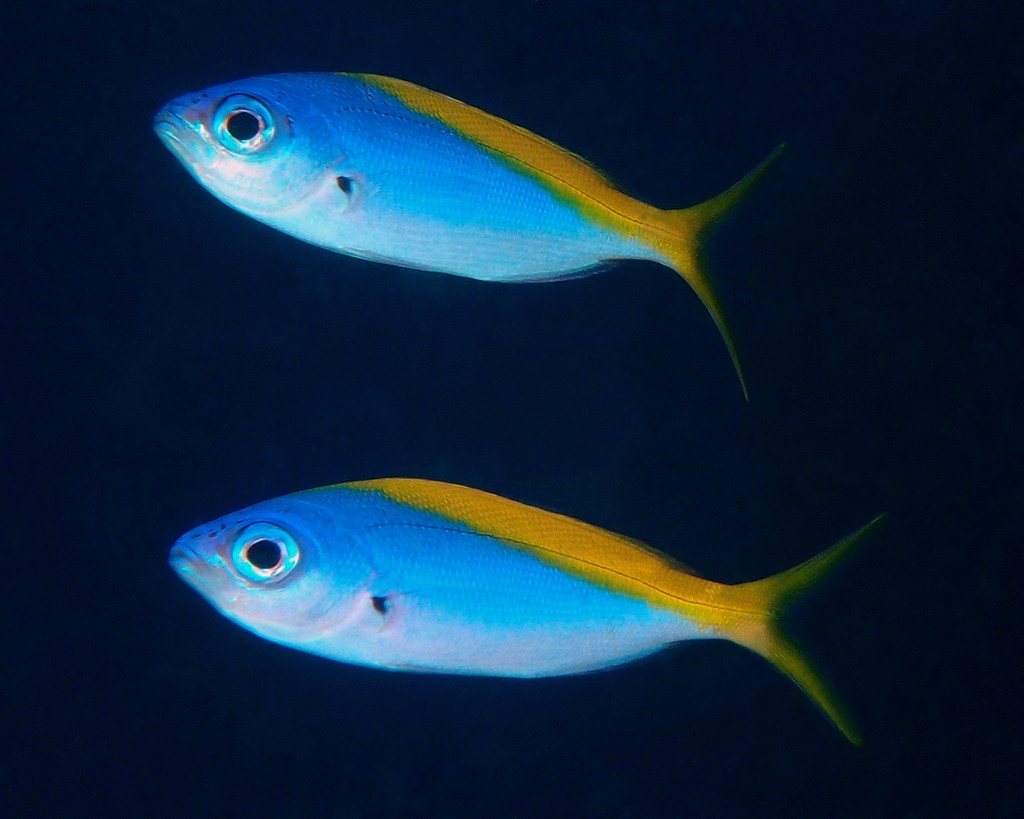CAESIO TERES - (SEALE, 1906)
Actinopterygii (Gigaclass) > Actinopteri (Class) > Teleostei (Subclass) > Lutjaniformes (Order) > Lutjanidae (Family) > Lutjaninae (Subfamily) > Caesio (Genus)
Caesio à queue jaune, Fusilier à dos jaune et bleu, Blue fusilier, Blue & gold fusilier, Yellow and blueback fusilier, Yellow-and-blueback fusilier, Fusilero amarillo azulado, Fuzileiro bonito, Pragtige piesang, Umeiromodoki, ウメイロモドキ, 乌尾冬仔,
Caesio à queue jaune, Fusilier à dos jaune et bleu, Blue fusilier, Blue & gold fusilier, Yellow and blueback fusilier, Yellow-and-blueback fusilier, Fusilero amarillo azulado, Fuzileiro bonito, Pragtige piesang, Umeiromodoki, ウメイロモドキ, 乌尾冬仔,
Synonymes
Caesio pulcherrima (Smith & Smith, 1963)
Caesio pulcherrimus (Smith & Smith, 1963)
Caesio pulcherrimus (Smith & Smith, 1963)
---------------------------
Description
Dorsal spines (total): 10; Dorsal soft rays (total): 14-16 (usually: 15); Anal spines: 3; Anal soft rays: 12-13 (usually: 12); Pectoral-fin rays: 18-23 (usually: 20-21); Lateral line scales: 51-61 (usually: 55); Scales above lateral line to dorsal origin: 7-10 (modally: 8), and below to anal-fin origin: 16-20; Predorsal scales: 20-28; Scales on cheek: 4-5; A single postmaxillary process; Supratemporal band of scales interrupted at dorsal midline by a narrow scaleless zone. Upper peduncular scale rows: 11-13; Lower peduncular scale rows: 14-17 (usually: 15-16). A small process on each ventrolateral surface of basioccipital for attachment of Baudelot's ligament. Head length: 2.6-3.6 in SL; Body depth: 2.7-4.2 in SL. Max. length: 40.0 cm TL, common length: 26.6 cm SL. Depth range: 5 - 50 m.
Color
Tail fin and peduncle, and body above a diagonal from just anterior to origin of dorsal fin to ventral origin of caudal peduncle bright yellow (except in large ones in western Pacific, yellow does not extend as far as anteriorly); Rest of upper 2/3 of body bright blue; Lower third silvery white. Indonesian populations have yellow from origin of dorsal and most of the back to below lateral line over the posterior part and tail.
Etymology
Caesio: from Latin, caesius = blue-grey or bluish-grey. Referring to upper body of Caesio caerulaurea, described as a “sky blue most pleasant to the eye”.
teres: from Latin, terō = rounded, polished, smooth. Referring to more cylindrical shape compared to Caesio lunaris.
Original description: Caesio teres Seale, 1906 - Type locality: Shortland Island, Solomon Islands, western Pacific.
Distribution
Indo-West Pacific: East Africa, Mozambique Channel, Seychelles, Madagascar and western Mascarenes east to Kiribati (Line Islands), Samoa and Tonga, north to southern Japan, south to off northwestern Australia, Queensland (Australia) and New Caledonia.
Description
Dorsal spines (total): 10; Dorsal soft rays (total): 14-16 (usually: 15); Anal spines: 3; Anal soft rays: 12-13 (usually: 12); Pectoral-fin rays: 18-23 (usually: 20-21); Lateral line scales: 51-61 (usually: 55); Scales above lateral line to dorsal origin: 7-10 (modally: 8), and below to anal-fin origin: 16-20; Predorsal scales: 20-28; Scales on cheek: 4-5; A single postmaxillary process; Supratemporal band of scales interrupted at dorsal midline by a narrow scaleless zone. Upper peduncular scale rows: 11-13; Lower peduncular scale rows: 14-17 (usually: 15-16). A small process on each ventrolateral surface of basioccipital for attachment of Baudelot's ligament. Head length: 2.6-3.6 in SL; Body depth: 2.7-4.2 in SL. Max. length: 40.0 cm TL, common length: 26.6 cm SL. Depth range: 5 - 50 m.
Color
Tail fin and peduncle, and body above a diagonal from just anterior to origin of dorsal fin to ventral origin of caudal peduncle bright yellow (except in large ones in western Pacific, yellow does not extend as far as anteriorly); Rest of upper 2/3 of body bright blue; Lower third silvery white. Indonesian populations have yellow from origin of dorsal and most of the back to below lateral line over the posterior part and tail.
Etymology
Caesio: from Latin, caesius = blue-grey or bluish-grey. Referring to upper body of Caesio caerulaurea, described as a “sky blue most pleasant to the eye”.
teres: from Latin, terō = rounded, polished, smooth. Referring to more cylindrical shape compared to Caesio lunaris.
Original description: Caesio teres Seale, 1906 - Type locality: Shortland Island, Solomon Islands, western Pacific.
Distribution
Indo-West Pacific: East Africa, Mozambique Channel, Seychelles, Madagascar and western Mascarenes east to Kiribati (Line Islands), Samoa and Tonga, north to southern Japan, south to off northwestern Australia, Queensland (Australia) and New Caledonia.
Biology
Adults are found primarily around coral reefs, with a preference for coralline lagoons. They feed on zooplankton in large midwater groups and form schools with other caesionids. Mature adults migrate to select areas around the reef to spawn near the surface in the entrances of deep channels during outgoing tides on a lunar cycle. They are oviparous, with numerous, small pelagic eggs. Are caught with drive-in nets.
Similar species
Caesio cuning (Bloch, 1791) - Reported from New Caledonia - Link to the species (here).
Caesio xanthonota (Bleeker, 1853) - Reported from Red Sea; Indian Ocean: East Africa, Socotra, Seychelles, Madagascar and Réunion (western Mascarenes) east to Indonesia, including Cocos-Keeling Island and Christmas Island (Australia). Overall blue, except yellow on back, and silvery on the underside.
Paracaesio xanthura (Bleeker, 1869) - Reported from New Caledonia - Link to the species (here).
Adults are found primarily around coral reefs, with a preference for coralline lagoons. They feed on zooplankton in large midwater groups and form schools with other caesionids. Mature adults migrate to select areas around the reef to spawn near the surface in the entrances of deep channels during outgoing tides on a lunar cycle. They are oviparous, with numerous, small pelagic eggs. Are caught with drive-in nets.
Similar species
Caesio cuning (Bloch, 1791) - Reported from New Caledonia - Link to the species (here).
Caesio xanthonota (Bleeker, 1853) - Reported from Red Sea; Indian Ocean: East Africa, Socotra, Seychelles, Madagascar and Réunion (western Mascarenes) east to Indonesia, including Cocos-Keeling Island and Christmas Island (Australia). Overall blue, except yellow on back, and silvery on the underside.
Paracaesio xanthura (Bleeker, 1869) - Reported from New Caledonia - Link to the species (here).
Last update: 21, August 2022
